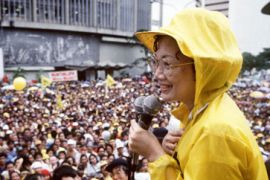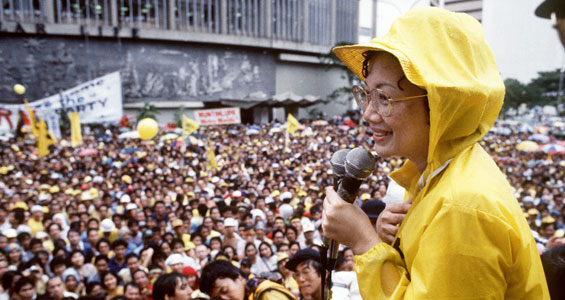Obituary: Corazon Aquino
Reluctant democracy icon toppled Philippines leader after husband’s assassination.

 |
| Aquino reluctantly led efforts to topple Ferdinand Marcos, the then Philippines ruler[AFP] |
Corazon Aquino was a reluctant political leader, thrust into the political limelight after the exile and subsequent assassination of her husband Benigno “Ninoy” Aquino, an opposition senator.
“I don’t know anything about the presidency,” she declared in 1985, a year before she agreed to run against Ferdinand Marcos, the authoritarian then-leader of the Philippines.
Aquino was born into the Cojuangco clan in the northern province of Tarlac on January 25, 1933. She was a product of power and wealth, but harboured no political ambitions until she met Ninoy.
The bright young journalist from another prominent Tarlac clan was seen as a president-in-waiting, but in September 1972, Marcos declared martial law and jailed hundreds of his opponents and critics, including Ninoy.
During this time, Aquino – known to many as “Cory” – helped the opposition movement, speaking on behalf of her husband and demanding democratic change.
When he went into exile in May 1980, Aquino joined him in the United States, a quiet time she described as the best period of their marriage.
Assassination
In 1983, against the advice of friends, Ninoy flew back to the Philippines from Boston to seek an audience with Marcos but before he could even get off the aircraft, he was shot dead.
Aquino returned and led a huge funeral procession for her husband with crowds estimated to be as high as two million people.
Under increasing pressure, Marcos called a snap election for 1986 and Aquino was encouraged to stand against him.
“I don’t seek vengeance, only justice, not only for Ninoy but for the suffering Filipino people,” she declared as she reluctantly accepted the nomination.
Marcos won the poll, which was marred by widespread reported irregularities, but with the support of the Catholic church, Aquino soon brought one million people onto the streets to protest.
The “People Power” movement was born and Marcos was quickly ousted.
Aquino was sworn in as president and quickly set up a commission to redraft the constitution, dismantled the network of Marcos supporters that controlled the economy and freed political activists.
Mixed legacy
She also started negotiations with communist and Muslim rebel groups, but her efforts were undermined by problems in her coalition government.
“I think her legacy will be a mixed one,” Al Jazeera’s Veronica Pedrosa said.
“There was so much hope riding on her administration but the truth is nothing has changed … the Philippines still has those two insurgencies in which people are dying every day.
“Endemic poverty also remains, while the population has almost doubled since 1986, so most Filipinos are looking at a future where they don’t know what’s going to happen.”
Aquino was also attacked over an agrarian reform bill that virtually exempted large plantations like her family’s sugar plantation from being distributed to landless farmers.
When farmers protested outside the Malacanang presidential palace on January 22, 1987, troops opened fire, killing 13 and wounding 100.
Aquino’s presidency was also undermined by at least seven attaempts to overthrow her government.
‘Painful’ decisions
In the 1990s, Aquino acknowledged the diffuclties of her time in the presidency.
“I realised that I could have made things easier for myself if I had done the popular things, rather than the painful but better ones in the long run,” she said.
“After all, in the long run, I wouldn’t be around to be blamed.”
After leaving the presidency in 1992, Aquino was constantly sought out to support political candidates and causes.
She became a vocal critic of Gloria Arroyo, the current president, whose family has been accused of massive corruption, and joined street protests against Arroyo until she was diagnosed with colon cancer in March of last year.
Time magazine made Aquino its woman of the year in 1986 and in 2006 named her one of Asia’s heroes, praising her “quiet courage” and describing her as “the symbol of People Power and an inspiration to others around the world struggling against tyranny”.